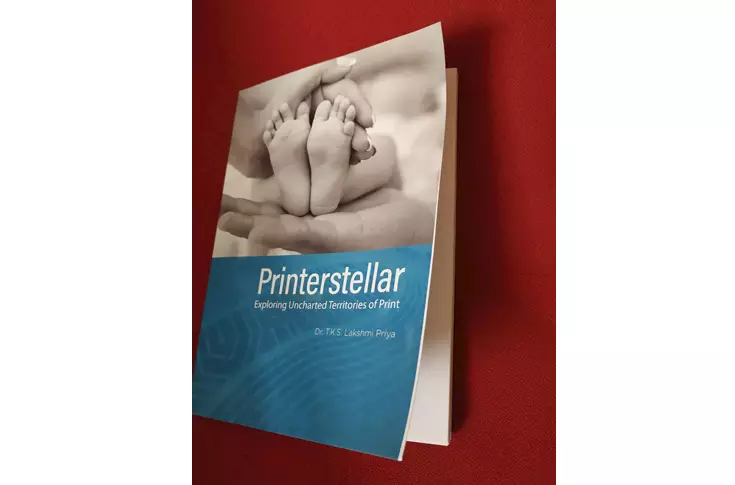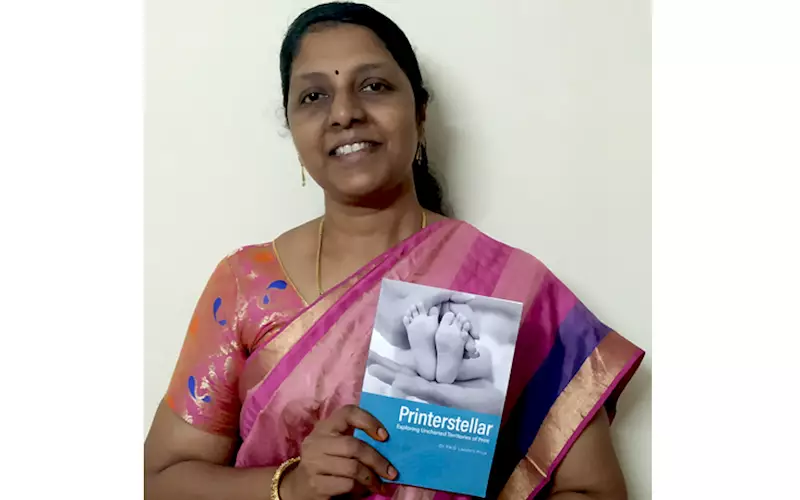TKS Lakshmi Priya: From a print teacher to an author
TKS Lakshmi Priya, professor and head, printing technology at Avinashilingam Institute for Women, Coimbatore, has come up with a book, titled, Printerstellar: Exploring Uncharted Territories of Print. Starting with exploring lesser-known facts about paper, the book introduces some recent technologies and how they have a link to the printing industry. The book also includes the author’s personal experiment of working in a printing technology institute. Lakshmi Priya shares how tracking the recent technological advances enabled her to write her book.
09 Dec 2022 | By Charmiane Alexander
When I wrote the article, ‘Smart printers use smartphones’ for Compria’s Printing News in 2015, writing a book wasn’t in my agenda. I gained confidence in my writings after I got feedback for my story ‘A visit to the HP Indigo centre in Singapore’ in the Noel D'Cunha Sunday Column in October 2016. It made me feel good that the articles were being well-received. In fact, when we met Alon Bar-Shany at the inauguration of HP Centre in Chennai, A Appadurai of HP introduced me by referring to that Sunday Column.
Sustainability and paper
Paper traders, mills and many industry stakeholders have been talking about the eco-friendly aspects of paper over computers for a long time. It is the ubiquitous nature of the digital world that is disrupting the truth about the goodness of paper. Therefore, a greater effort is needed to prove the point and so, I have made this the first chapter for Printersteller.
Print 4.0
The concept of Print 4.0 was made popular at Drupa in 2016, which was more than five years ago. Looking at the pace at which technology is evolving, isn’t it necessary that printers (particularly small and medium scale) catch up with it? Did we resist smartphones? No. Then, why must we resist trending technology? While adopting new technologies is essential, this is not the only solution for our industry. I am highlighting Print 4.0 because I understand both sides of the coin (computer technology and printing technology). I have also worked and researched on the subject that can benefit small printers. Three articles in the second section of Printersteller reflect this.
Creating future print technocrats
From the education perspective, the National Education Policy (NEP) is being implemented across the country. This aims to educate people in such a way that it leads to a much better society and promotes national development. In this light, print education must also make students think about how print can be associated with every other discipline and work on new product developments (NPD) that are useful for society.
The third section of Printerstellar talks about how students can be engaged with the community by using their printing skills. This, as a result, can inculcate a feeling of giving back to society. Although the book is written from a printing industry and education perspective, the core takeaways of all my articles are applicable to students of any discipline. The third section of the book is about lending a helping hand to educate the underprivileged community with the skills that one possesses. I have used words like pride and treasures in the chapter heading to refer to the human intention to serve society.

Outreaches & OER
Big companies and associations are already doing laudable CSR activities. Through Printerstellar, I wish to convey that the power of print and printing skills be promoted via the CSR activities. Society sees printing as a black collar job and that printers lead a dissatisfied job life. Open Education Resources (OERs) are another means to both offer a service and to promote print. One of the chapters in the book is about OERs that were developed for hearing-impaired school children.
Need for innovation
Printers have a greater responsibility given the core strength of print as an innovation rather than merely associating themselves with the face value of printing. Print preserves information, knowledge, and legacy. Print facilitates development, evolution, and society. Therefore, today’s printers have to make a call to right the imbalances through sustainability and pave the way for the future society.
Print can contribute largely to level out the differences. Much can be done on these lines. For instance, two of my articles in Printerstellar speak about print-related techniques that can cleanse lakes and make smart walls and these are viable sustainable small business ideas.
Knitted with human life
Printing is a versatile industry. It has sustained four industrial eras and is closely knitted to human life. Every printer experiences the immense pride of creation upon completing each job. I have learnt many lessons from them, including the most important one — that change is inevitable. So, it is important to keep doing good things to overcome obstacles. Flawlessness will need to be practised as presentation is important.
Making the book
Printersteller is a compendium of my earlier articles that I had written for various print magazines. Each article in the book is based on research, experimentation and evaluation. It then culminated as a tip or recommendation to small printers.
Having visited many printing and allied units across the country, I have seen to some extent that SMEs are hesitant to adopt cross media technology. As they needed support, I have been including recommendations in my articles. Most of the articles present new concepts in a simple manner. Print can never die but only evolve into something better.











 See All
See All